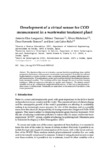Development of a Virtual Sensor for COD Measurement in a Wastewater Treatment Plant

Use este enlace para citar
http://hdl.handle.net/2183/34120
Excepto si se señala otra cosa, la licencia del ítem se describe como Attribution 4.0 International (CC BY 4.0)
Metadatos
Mostrar el registro completo del ítemTítulo
Development of a Virtual Sensor for COD Measurement in a Wastewater Treatment PlantAutor(es)
Fecha
2023Resumen
[Abstract] The objective of the work is to develop a system that allows predicting, from a global
perspective, the behavior of the process in a wastewater treatment plant. To do this, the chemical
oxygen demand, a variable present in water, is estimated indirectly, avoiding difficult and
complex measurements. This estimation is carried out in real time through the relationship between
easily measured variables. This modeling will be done through the use of machine learning
techniques. Different regression techniques are applied and compared. The dataset contains
variables such as pH, conductivity, suspended solids and etc. In thisway, a non-physical indirect
sensor is implemented. Thresholds are established for the detection of deviations in the sensor
parameters
Palabras clave
Aprendizaje automático
Conjunto de datos
Aguas residuales
Conjunto de datos
Aguas residuales
Descripción
Cursos e Congresos , C-155
Versión del editor
Derechos
Attribution 4.0 International (CC BY 4.0)






